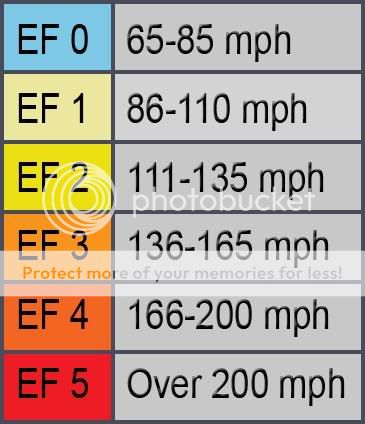What is a tornado?
A tornado is: "A localized and violently destructive windstorm occurring over land characterized by a funnel-shaped cloud extending toward the ground." It was first used in 1556.
Where do tornadoes come from?
Tornadoes come from super cell thunderstorms. These storms are also known as Meso-cyclone storms and occur most commonly on the plains of the American Midwest.
When and where do most tornadoes occur?
Most tornadoes occur in a swath known as Tornado Alley. This ranges from Canada to Mexico, from Colorado to the Mississippi River and east. Tornadoes most often occur from Spring until late Summer, the peak for tornadoes is usually April to June. However Tornadoes have formed in every month of the year.
What are the warning signs of a Tornado?
All tornadoes form from a lowering in the thunderstorm called a Wall Cloud. This is a rotating cloud feature at the back of the storm. If you see a wall cloud and it is rotating watch for protrusions near the bottom. A tornado may already be on the ground even if you do not see the condensation funnel itself. So always watch for dust swirls and debris under the wall cloud and or funnel.
It looks stormy out, how do I know if there is a Tornado coming?
Always pay attention to TV, radio, or internet when stormy weather is approaching. If the National Weather Service determines that conditions exist for bad weather they will issue a Severe Thunderstorm Watch. This means severe weather is possible. If a severe storm develops they will issue a Severe Thunderstorm Warning. If information shows that tornado development is possible they will issue a Tornado Watch, and if radar shows strong rotation, or if a tornado/funnel is sighted a Tornado Warning. *(It is NOT always required to have severe thunderstorm watches or warnings for a storm to produce a tornado, likewise sometimes storms gather strength so quickly that no tornado watch is issued.)
The NWS has issued a Tornado Warning for my area, what do I do?
Get indoors immediately and head to the basement or center-most room of your home such as a closet or bathroom.If you are in a vehicle, seek shelter in a building, or ditch. If you are in a ditch, lie flat on the ground and cover your head.
If you are in a mobile home get out, they do not provide protection from the winds of a tornado.
Do Not
Do not open windows. It is a waste of time and does not help save your home.
Do not stand near windows, flying debris and strong winds can shatter glass and cause injury or death.
Do not attempt to outrun a tornado. Many tornado deaths occur with people in cars.
Do not seek shelter under an overpass. Although it is shown saving the lives of people in a popular 90's video in fact the compressed space increases tornado winds and can suck people right out. This was discovered in May of 1999 during the Oklahoma City tornado.
Do not remain outdoors if a tornado is near.
Do not attempt to save pets or property. The average warning time is 10-15 minutes but can be considerably less.
What are those funny letters and numbers used to measure Tornadoes?
This is a scale used to measure the damage and winds of a tornado. Originally called the Fujita-Pearson or 'F' Scale it has six levels of intensity. More recently as more is understood about tornadoes, the scale was revised and is now called the EF or Enhanced Fujita Scale.

It is debated by some if the so-called "Super Tornado" or EF 6 exists. An argument that was pressed heavily after the Oklahoma City Tornado, which had the highest tornado winds recorded.
 Artan Zuill Artan Zuill · Mon Nov 30, 2009 @ 04:20am · 0 Comments |